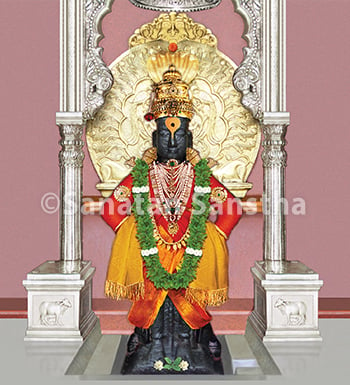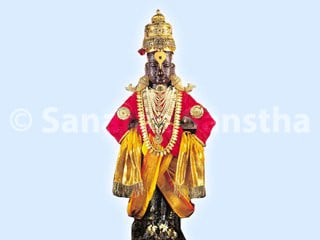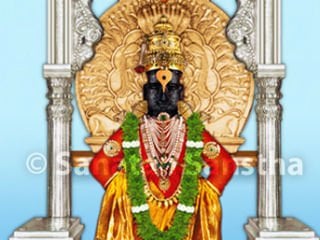Science underlying the Idol of Shri Vitthal at Pandharpur as told by the servitor performing puja of the idol, Shri. Mukund Bhagwan Pujari
Special features of the idol of Deity Vitthal
The entire idol
The part below the waist is of the form of Deity Brahma, that from the waist till the neck is that of Shrivishnu and the head that of Shiva.
Dark complexion
Though the colour of the Idol is black, in reality when a devotee gets a subtle vision of it, it appears white.
Forehead
This emits radiance from the Adnya chakra.
Hands placed on the waist
The sense organs lie above the waist where as the motor organs lie below it. Placing hands on the waist indicates that the motor organs are within His control.
2. The brick given by devotee Pundalik
Brick signifies the Pruthvitattva (Absolute Earth Principle). Worldly life commences from this Principle. In this way the worldly life and Spirituality has been nicely blended in the Idol of Deity Vitthal.
3. Pandurang
As per path of Yoga white colour signifies the nirgun (Non-materialized) Principle. The sagun (Materialised) form is called as ‘Shri Vitthal’ while the nirgun form is called as ‘Pandurang’.In the Himalayas most Shivalingas are white in colour. That is why Pandurang is both Mahadev and Vitthal.
4. Muktakeshi Dasi
The fingers of Muktakeshi Dasi are embedded in the feet of Pandurang. The imprint of the fingers is seen on Shri Vitthal’s Holy feet. One can attain salvation at the Holy feet of Shri Vitthal, however, Pandurang has manifested specially for Pundalik. That is why devotion is superior to salvation. The spiritual meaning derived from this is that ‘you attain salvation only through devotion’.
5. Equality of Shri Vitthal
For Shri Vitthal all are equal, none is great or small. In fact Pandurang is an icon of equality.
6. Anklets on the feet of Shri Vitthal
Man should decide the path he chooses to take and bind himself onto it. He should introspect whether he is treading on the unscrupulous or righteous path. Even when on the righteous path he should not be trapped in the bondage of ego. That is precisely why when following the righteous path he should form a set of rules and regulations. The anklets signify this. They also indicate that without judging as good or bad one should remain in the stance of an observer.
7. Sticks on both legs of Shri Vitthal
When cattle run helter-skelter the cowherd controls it using a stick. In the same way the shadripu (Six foes of the soul) manifest on and off and have to be controlled with a stick in the form of spiritual practice. You must live in self-control. The stick signifies this.
8. Shri Vitthal’s flowing dhoti
God wears a dhoti made of gold. In the path of meditation, blue complexion, white colour and finally golden colour signify radiance.The flowing dhoti of Shri Vitthal signifies this golden radiance.
9. A creeper of the sacred jackfruit tree (kardoda) on the waist
God has bound desires and six foes of the soul to His waist. He is everready for everything. Man too should do this.
10. The seat allotted to His consort Rukmini
This seat depicts that man and woman are equal and that a man is incomplete without a woman.
11. The Lord’s affectionate embrace (shrivatsalanchan)
This signifies the kick that Sage Bhrugu gave on His chest. God bore the hit on His chest without any kind of ego. In fact He has no qualms in carrying it on His chest. Through this He is teaching to control and overcome anger and ego within us.
12. A lotus petal in the right hand
This depicts peace.
13. Earrings in the shape of a fish
These earrings remind us to forget our defects. In the path of meditation other than the ears from the nine openings in the body, all others can be closed. Closure of ears is possible only in Nirvikalpa Samadhi (State of superconsciousness). A fish represents the Apa (Absolute Water Principle). Only when we conquer the Absolute Water Principle, then we can advance to the Absolute Air Principle. Only when we reach the Absolute Air Principle we find it easy to attain Nirvikalpa Samadhi and acquire control over the sound, i.e. able to close the ears. This what those earrings symbolise.
14. Form of the pindi of
Mahadev on the forehead of Shri Vitthal
Chidakash (Absolute Ether) is present above the midbrow region. The pure awareness within this Absolute Ether itself is called Paramatma (Supreme Soul). It is the non-materialised form of Mahadev.
The vision of Shri Vitthal commences from the brick i.e. from His materialised form and concludes with a vison of the pindi of Mahadev. In spiritual practice, ‘soham, soham’ or ‘hansoham’ is uttered. When you say ‘soham, soham’ your breath gets steadied and becomes slow. Then it reaches Absolute Ether. The pure awarenesss devoid of ego occurring in Absolute Ether is the awareness of ‘soham’ or ‘aham Brahmasmi’ (I am Brahman).
(Important points compiled after hearing the sound at the Holy place of pilgrimage of Pandharpur and the science underlying the worship of Shri Vitthal.)
Reasons for Adya Shankaracharya denoting Pandharpur a ‘Mahayogapeeth’
‘A place of pilgrimage is either a Yogapeeth (Seat for yoga) or Shaktipeeth (Seat of Divine Energy) but Adya Shankaracharya has referred to Pandharpur as a ‘Mahayogapeeth’. Devotees visit a place of pilgrimage for a vision of a Deity but here in Pandharpur, Pandurang is standing, waiting for His devotee Pundalik. Since Parameshwar (Supreme God) is waiting for the arrival of His devotees, this is a Mahayogapeeth. The Idol of Shri Vitthal at Pandharpur is a unique blend of His materialised and non-materialised forms.’
– Mr. Mukund Bhagwan Pujari, Pandharpur
Three types of peethas (Seats of worship) in Hindu Dharma as per Vastushastra (Science of premises)
1. Bhaktipeeth, 2. Gajapeeth and 3. Shaktipeeth
1. Bhaktipeeth
A territory in the shape of the back of a tortoise is a Bhaktipeeth. This land is sloping on all four sides. It is also called as Kurmapeeth (Kurma means tortoise). It depicts that just as a tortoise withdraws its body into its shell so also a devotee should come to worship God with a spiritual emotion of surrender, leaving behind his ego, shortcomings etc. Not just devotees but Deities and demons too surrender at such peethas.
1A. Reasons for calling Pandharpur a Bhaktipeeth
No matter how atheistic an individual is, when he comes to Pandharpur he gets charged with devotion. That is precisely why Pandharpur is called a ‘Bhaktipeeth’.
2. Gajapeeth
A place of pilgrimage which has flow of water and water resources at its north-east side, and high mountains in the south and south-west side, is called a Gajapeeth. An excellent example of this is peeth of Tirupati Balaji. It is considered the best Gajapeeth.
3. Shaktipeeth
The place where a temple is located in a Shaktipeeth, has a slope is fully towards the west direction. Most Shaktipeeths are associated with Devi (Female Deity).The slope of Shri Bhavani temple in Tuljapur and Shri Mahalakshmi temple in Kolhapur is to the west.
Shri Vitthal is God’s ninth incarnation – Bouddhavtar
Pandharpur is the peeth of God’s ninth incarnation in the Kaliyug. Shri Vitthal is the incarnation of Shrivishnu. Bouddha is the ninth incarnation of God. Bouddha means bonded, the one bound to the word of the devotee, the one who is there for the sake of devotees.
Mr. Narsinha alias Prashant Sakharam Pujari, Pandharpur (one of the seven servitors of Shri Vitthal)


 Aarti of Vitthal
Aarti of Vitthal Shri Vitthal – the Deity from Pandharpur !
Shri Vitthal – the Deity from Pandharpur !
Sri Hari Vittala Jai Hari Vittala 🙏 🙏 ananta koti namaskarangal for this priceless valuable share, Guru vandanam 🙏 blessed
namaste.
Great information, our sastanga pranam. well explained. we are proud to be his devotees.
Dhanyavad.
Daasara Dasa.
mohankumar